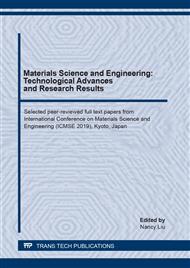[1]
Q. Li, Z. Chen, J.-T. Zhang, L.-C. Liu, X. Li, L. Jia, Positioning and revision of CCUS technology development in China, International Journal of Greenhouse Gas Control, 46 (2016) 282-293.
DOI: 10.1016/j.ijggc.2015.02.024
Google Scholar
[2]
H. Liu, P. Were, Q. Li, Y. Gou, Z. Hou, Worldwide status of CCUS technologies and their development and challenges in China, Geofluids, 2017 (2017).
DOI: 10.1155/2017/6126505
Google Scholar
[3]
A.-M. Cormos, C.-C. Cormos, Techno-economic evaluations of post-combustion CO2 capture from sub-and super-critical circulated fluidised bed combustion (CFBC) power plants, Applied Thermal Engineering, 127 (2017) 106-115.
DOI: 10.1016/j.applthermaleng.2017.08.009
Google Scholar
[4]
E. Oko, M. Wang, A.S. Joel, Current status and future development of solvent-based carbon capture, International Journal of Coal Science & Technology, 4 (2017) 5-14.
DOI: 10.1007/s40789-017-0159-0
Google Scholar
[5]
U.H. Bhatti, A.K. Shah, J.N. Kim, J.K. You, S.H. Choi, D.H. Lim, S. Nam, Y.H. Park, I.H. Baek, Effects of transition metal oxide catalysts on MEA solvent regeneration for the post-combustion carbon capture process, ACS Sustainable Chemistry & Engineering, 5 (2017) 5862-5868.
DOI: 10.1021/acssuschemeng.7b00604
Google Scholar
[6]
T.H. Nguyen, S. Kim, M. Yoon, T.H. Bae, Hierarchical zeolites with amine‐functionalized mesoporous domains for carbon dioxide capture, ChemSusChem, 9 (2016) 455-461.
DOI: 10.1002/cssc.201600004
Google Scholar
[7]
X. Lv, L. Li, S. Tang, C. Wang, X. Zhao, High CO2/H2 and CO2/CH4 selectivity in a chiral metal-organic framework with contracted pores and multiple functionalities, Chem Commun, (2014) pp.6886-6889.
DOI: 10.1039/c4cc00334a
Google Scholar
[8]
N. Minju, P. Abhilash, B.N. Nair, A.P. Mohamed, S. Ananthakumar, Amine impregnated porous silica gel sorbents synthesized from water–glass precursors for CO2 capturing, Chemical Engineering Journal, 269 (2015) 335-342.
DOI: 10.1016/j.cej.2015.01.069
Google Scholar
[9]
K. Li, J. Jiang, S. Tian, F. Yan, X. Chen, Polyethyleneimine–nano silica composites: a low-cost and promising adsorbent for CO 2 capture, Journal of Materials Chemistry A, 3 (2015) 2166-2175.
DOI: 10.1039/c4ta04275a
Google Scholar
[10]
Q. Liu, J. Shi, Q. Wang, M. Tao, Y. He, Y. Shi, Carbon dioxide capture with polyethylenimine-functionalized industrial-grade multiwalled carbon nanotubes, Industrial & Engineering Chemistry Research, 53 (2014) 17468-17475.
DOI: 10.1021/ie503118j
Google Scholar
[11]
S. Jeon, H. Jung, D.H. Jo, S.H. Kim, Development of crosslinked PEI solid adsorbents for CO2 capture, Energy Procedia, 114 (2017) 2287-2293.
DOI: 10.1016/j.egypro.2017.03.1373
Google Scholar
[12]
H. Zhang, A. Goeppert, G.A. Olah, G.S. Prakash, Remarkable effect of moisture on the CO2 adsorption of nano-silica supported linear and branched polyethylenimine, Journal of CO2 Utilization, 19 (2017) 91-99.
DOI: 10.1016/j.jcou.2017.03.008
Google Scholar
[13]
X. Liu, F. Gao, J. Xu, L. Zhou, H. Liu, J. Hu, Zeolite@ Mesoporous silica-supported-amine hybrids for the capture of CO2 in the presence of water, Microporous and Mesoporous Materials, 222 (2016) 113-119.
DOI: 10.1016/j.micromeso.2015.10.006
Google Scholar
[14]
Y. Lin, Q. Yan, C. Kong, L. Chen, Polyethyleneimine incorporated metal-organic frameworks adsorbent for highly selective CO 2 capture, Scientific reports, 3 (2013) 1859.
DOI: 10.1038/srep01859
Google Scholar
[15]
Y. Sun, X. Liu, C. Sun, W. Al-Sarraf, K.Z. Foo, Y. Meng, S. Lee, W. Wang, H. Liu, Synthesis and functionalisation of spherical meso-, hybrid meso/macro-and macro-porous cellular silica foam materials with regulated pore sizes for CO 2 capture, Journal of Materials Chemistry A, 6 (2018) 23587-23601.
DOI: 10.1039/c8ta06224b
Google Scholar
[16]
S. Liu, L. Chen, X. Mu, M. Xu, J. Yu, G. Yang, X. Luo, H. Zhao, T. Wu, Development of Pdn/g-C3N4 adsorbent for Hg0 removal–DFT study of influences of the support and Pd cluster size, Fuel, 254 (2019) 115537.
DOI: 10.1016/j.fuel.2019.05.120
Google Scholar
[17]
B. Zhao, Y.-x. Pan, C.-j. Liu, The promotion effect of CeO2 on CO2 adsorption and hydrogenation over Ga2O3, Catalysis Today, 194 (2012) 60-64.
DOI: 10.1016/j.cattod.2012.05.011
Google Scholar


